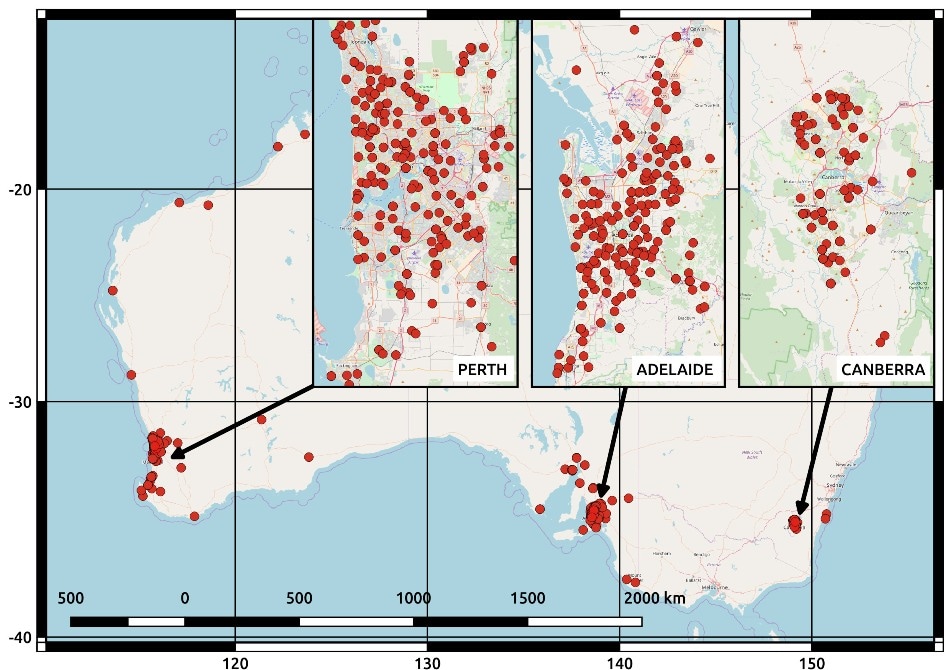May 29 2019
Conventionally, solar power scientists have estimated the power produced within a city only using the power measurements from single residential solar photovoltaic (PV) systems.
 Map of Australia highlighting Perth, Western Australia; Adelaide, South Australia; and Canberra, Australian Capital Territory. Each red marker represents the location of the PV systems within the database. Longitude and latitude are reported in degrees. (Image credit: Australian National University)
Map of Australia highlighting Perth, Western Australia; Adelaide, South Australia; and Canberra, Australian Capital Territory. Each red marker represents the location of the PV systems within the database. Longitude and latitude are reported in degrees. (Image credit: Australian National University)
However, one installation cannot account for all the rooftops in the city, where the panel direction, time of day, and shade cast by clouds and trees influence the production of power.
Data obtained from PV systems distributed throughout a city are very much required to completely understand the integration of this renewable energy source into the power grid with no interruption in the steady flow of electricity on which the developing world is dependent.
Engineers at the Australian National University and Fraunhofer-Institute for Solar Energy Systems ISE, Germany, have generated a freely available, quality-controlled, and tuned dataset from 1287 residential installations across Australia. The dataset has been published in the Journal of Renewable and Sustainable Energy, from AIP Publishing.
Jamie Bright described the dataset as “a gift” for solar scientists and explained that “No one has delivered a freely accessible piece of data that has six months’ worth of measurements from three different cities. That is a significant amount.”
Bright reported that earlier, scientists had been forced to extremes to collect power measurements to design cloud models that move across a city to “fake” PV power output for various locations.
For the first time, you are able to easily access data and do the sort of spatial analysis needed to manage solar integration into the grid in a controlled way.
Jamie Bright, Australian National University
In Australia, where nearly 23% of all domestic homes have PV systems, this is specifically relevant for the reliable and safe management of the grid. For example, grid operators are required to react and plan for the fluctuations in solar power for maintaining the recommended voltage for appliances and for ensuring electricity supply.
With subscription to a public website—pvoutput.org—Bright and coworkers can access raw PV power data provided by the automatic logging of PV system’s electrical converters. A computer programmer obtained data from the website and stored into a database for the engineers, who later gathered characteristic details about each PV system, like its efficiency and size. They used this metadata alongside satellite images and carried out rigorous quality controls and trained tuning algorithms on the dataset to remove any “bad data.”
Our tuning routine is a catchall method of finding all the possible systemlike losses, such as shading, and removing them from the data. Not just deleting them, but scaling it back up to make it representative.
Jamie Bright, Australian National University
Later, the representative scenario is possibly extrapolated to larger areas and is used along with satellites to enhance solar forecasting.
Now we’ve proved with this dataset that live reporting PV systems can significantly improve forecasting—solar forecasting companies are deploying our approach to a real operational industrial forecasting system.
Jamie Bright, Australian National University
Using the codes and instructions in their dataset at each processing stage, it is hoped by Bright that these are beneficial to other scientists.